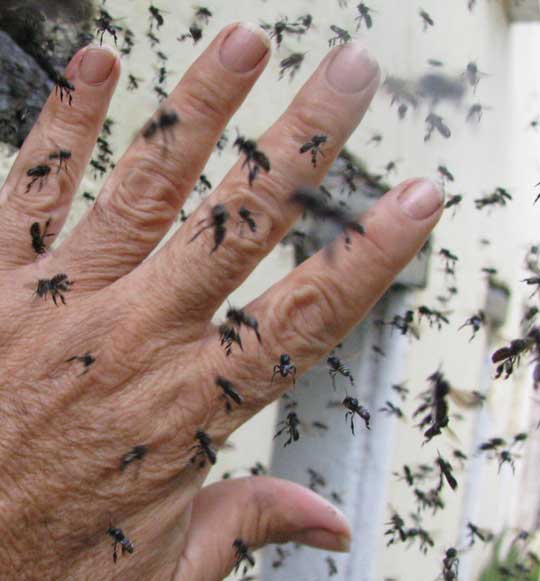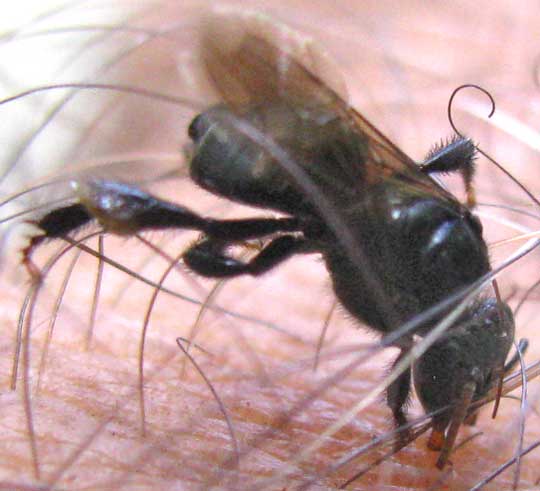Excerpts from Jim Conrad's
Naturalist Newsletter
from the March 6, 2011 Newsletter issued from Hacienda Chichen Resort beside Chichén Itzá Ruins, central Yucatán, MÉXICO; limestone bedrock, elevation ~39m (~128ft), ~N20.676°, ~W88.569°
STINGLESS BEES SWARMING
A cloud of smallish, fast flying, buzzing bees swarmed outside a storage room's window up at Hacienda Chichen's colonial church, as shown below:

I put my hand into the cloud, as you can see below:

Though they really were bees, I didn't fear being stung because these were stingless bees. Stingless bees are famous in the Yucatan because two species of stingless bee are cultured by the Yucatán's Maya, Melipona beecheii and M. yucatanica, with beecheii being the favorite. Though stingless bees don't sting, they do tend to tangle threateningly in one's hair, and bite, as shown below:

The bites don't hurt, though, mostly just scare you if you don't know how innocuous they are.
Often people refer to stingless bees as melipine bees because they belong to the bee tribe called the Meliponini. That name avoids the question of which species is being dealt with, and hints of the fact that other species of stingless bees also exist. As well as in the Americas, stingless bees occur in Africa, Australia and Southeast Asia.
That day the bees were swarming outside a cluster of nest "pots" and remnants of pots in a cavity formed where a window's wooden lintel had rotted away, shown below:

The pots look those of mud-dauber wasps, but instead of mud they're composed of a mixture of beeswax and various types of plant resin. In 2005 near Dzemul in northwestern Yucatán I photographed a smaller, neater cluster of pots -- probably a different species -- where it was easier to see how thin the pots' walls were and how the pots structurally related to one another. That photo is show below:

The ancient Maya regarded stingless bees as sacred, and the bees' honey was very important to them. In the 112-page Madrid Codex, one of few "Maya books" escaping destruction by the conquering Spaniards, ten pages are dedicated to stingless bees.
Since I got here I've been noticing some curiously hollowed-out log sections stacked against a tree, wondering what they were doing there. Now I've learned that they are traditional hives local beekeepers once used for their stingless bees. The log sections are shown below:

These are fascinating and beautiful creatures but they're fast disappearing because of habitat destruction, insecticide use and competition from introduced bee types. You might enjoy reading the unusually informative Wikipedia page on stingless bees at https://en.wikipedia.org/wiki/Stingless_bee.